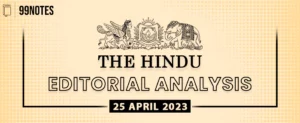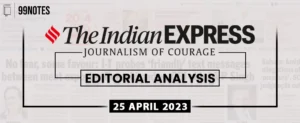26 April 2024 : Daily Current Affairs
Daily Current Affairs
26-April -2024- Top News of the Day
1. Ocean floor holds vital clues on weather patterns, says study by INCOIS scientists
| Topic: GS1 – Geography – World’s physical geography
Understanding ocean currents (esp. near India) is vital for UPSC as it impacts weather, climate (Indian subcontinent) and maritime activities. |
| Context: |
| ● Study of Indian Ocean floor improves understanding of currents, especially near the Maldives, which significantly affect deep ocean flow. |
Additional information on this news:
- A recent study by scientists at the Indian National Centre for Ocean Information Services (INCOIS) revealed the significant influence of Andaman and Nicobar Islands and the Maldives islands on Indian Ocean currents.
- Deep-swirling patterns in the ocean depths, opposite to surface currents, were discovered, altering direction and speed significantly.
- Scientists Raheema Rahman and Hasibur Rahaman conducted a study on Indian Ocean bathymetry, showing improvement in upper ocean salinity, temperature, and currents, especially near the coast.
- Accurate forecasts of oceanographic parameters like currents, temperature, and salinity are crucial for weather, climate prediction, and maritime industry.
- The study underscores the importance of bathymetry in enhancing understanding of ocean dynamics to improve ocean state forecasts, weather, and climate forecasts for Indian rim countries and the subcontinent.
- Titled ‘Impact of bathymetry on Indian Ocean circulation in a nested regional ocean model,’ the study was published in the Scientific Reports journal.
| PYQ: Explain the factors responsible for the origin of ocean currents. How do they influence regional climates, fishing and navigation? (200 words/12.5m) (UPSC CSE (M) GS-1 2015) |
| Practice Question: What role do the Andaman and Nicobar Islands and the Maldives islands play in influencing Indian Ocean currents? How does bathymetry contribute to our understanding of weather and climate forecasting? (150 Words /10 marks) |
2. SC declines petition to end Collegium, revive NJAC
| Topic: GS2 – Indian Polity – Judiciary
Tests understanding of judicial appointment debate (Collegium vs NJAC) and its impact on judicial independence (UPSC focus). |
| Context: |
| ● Supreme Court rejects attempt to revive government involvement in judicial appointments (NJAC) and upholds the existing Collegium system. |
Additional information on this news:
- The Supreme Court Registry has refused to accept a petition seeking to end the Collegium system of judicial appointments and revive the National Judicial Appointments Commission (NJAC).
- The Supreme Court cited that the Collegium system has already been upheld by the Supreme Court, while the NJAC was struck down as unconstitutional in 2015. A review plea against this judgment was also dismissed in 2018.
- The Registrar said the petition only “replicated” issues already adjudicated, and that allowing such repeat litigation would be against the public’s best interest and could be driven by an “ulterior motive”.
- The Registrar invoked the Supreme Court Rules to decline registering the petition, stating it disclosed no reasonable cause or was frivolous.
- The petition argued the 2015 judgement that revived the Collegium system went against the “will of the people” by striking down the NJAC, which the petitioners called a “synonym for nepotism and favouritism”
| Collegium vs NJAC Debate |
| ● The Collegium system is a process where judges appoint judges. It originated from a series of judgments by the Supreme Court, most notably the “Three Judges Cases” in the 1980s and 1990s.
● The National Judicial Appointments Commission (NJAC) was proposed as an alternative to the Collegium system, aiming to introduce more transparency and accountability in judicial appointments. ● The NJAC was established through the 99th Constitutional Amendment Act, 2014, and sought to include the Chief Justice of India, two senior-most judges of the Supreme Court, the Law Minister, and two eminent persons as members. ● However, the Supreme Court struck down the NJAC Act in 2015, declaring it unconstitutional. The court argued that it undermined the independence of the judiciary by giving the executive and other non-judicial members a say in judicial appointments. ● Proponents of the Collegium system argue that it ensures judicial independence and prevents political interference in appointments. ● Critics of the Collegium system point out its lack of transparency and accountability, with decisions made behind closed doors without any input from other branches of government or civil society. ● The debate over Collegium vs. NJAC continues, with some advocating for reforms within the Collegium system to address its shortcomings, while others push for a revised version of the NJAC that respects the principles of judicial independence. |
| PYQ: Critically examine the Supreme Court’s judgement on ‘National Judicial Appointments Commission Act, 2014’ with reference to appointment of judges of higher judiciary in India. (150 words/10m) (UPSC CSE (M) GS-2 2017) |
| Practice Question: Critically examine the Collegium system, highlighting its strengths and weaknesses. Discuss the potential advantages and disadvantages of the NJAC Act. In your opinion, what is the best way forward to ensure an independent and accountable judiciary in India? (250 Words /15 marks) |
3. Intellectual property: India features yet again on U.S.’ ‘priority watch list’
| Topic: GS3 – Science & Technology – Issues relating to IPR
GS2 – International Relations – Effect of policies and politics of developed countries on India’s interests This issue touches upon India’s trade relations with the US and balancing intellectual property rights with access to medicines (UPSC focus on international trade & IPR Regime). |
| Context: |
| ● US criticizes India for weak intellectual property protections, placing it on a priority watch list alongside China and Russia. |
Additional information on this news:
- US Criticism: The US Trade Representative (USTR) has again included India on its “priority watch list” for issues related to Intellectual Property (IP) protection and enforcement.
- Similar Countries: China, Russia, Venezuela, Indonesia, Chile, and Argentina are also on the list.
- Areas of Concern: The USTR report cites inadequate IP enforcement, high online piracy, a backlog in handling trademark challenges, and insufficient legal protection for trade secrets in India.
- India’s Response: India maintains its IP laws comply with World Trade Organization (WTO) agreements and says it’s not obligated to make changes based on other international rules.
- USTR Report: The annual Special 301 Report assesses IP protection in trading partner countries.
- Priority Watch List: This designation indicates “serious problems” with IP protection or enforcement in a country. While no immediate action is taken, it signifies an area of concern for the US.
- Potential Consequences: If India’s standing worsens to a “priority country,” the US could impose trade sanctions.
- Other Countries: The report also includes a “watch list” of 20 countries with less severe IP issues that still require US attention.
Additional Notes:
- The report highlights India’s need to fully implement World Intellectual Property Organization (WIPO) internet treaties and ensure copyright limitations don’t extend unnecessarily.
- The US-India Trade Policy Forum has seen some progress on trademark investigations and patent procedures, but broader concerns remain.
| IPR regime India |
| Issues with India’s IPR Regime:
● Weak Enforcement: India struggles to enforce IP rights, leading to issues like high online piracy rates and counterfeit goods. ● Backlogs and Delays: The trademark opposition system faces a significant backlog, hindering timely resolution of disputes. ● Trade Secret Concerns: India’s legal framework is seen as inadequate in protecting trade secrets compared to international standards. ● Balancing Act: India faces pressure to strengthen IP protection but also desires policy space to ensure access to medicines and affordable technologies crucial for development. ● Compliance vs. Development: Stricter IP regimes can raise costs of medicines and technologies, potentially hindering public health and access to knowledge. Way Forward for a Stronger IPR Regime: ● Strengthen Enforcement: Invest in robust enforcement mechanisms to tackle piracy and counterfeiting. ● Streamline Processes: Improve efficiency in the trademark and patent offices to reduce backlogs and expedite decisions. ● Legislative Reforms: Consider legal changes to enhance trade secret protection and align with evolving technological landscapes. ● International Cooperation: Collaborate with international bodies like WIPO to implement best practices in IP protection. ● Stakeholder Dialogue: Foster open discussions between rights holders, domestic industries, and public health advocates to find a balanced approach. Overall, India needs to find an equilibrium between strengthening its IPR regime to attract innovation and investment while safeguarding its development priorities. |
| PYQ: In a globalised world, intellectual property rights assume significance and are a source of litigation. Broadly distinguish between the terms – copyrights, patents and trade secrets. (200 words/12.5m) (UPSC CSE (M) GS-3 2014) |
| Practice Question: Critically examine the U.S. concerns regarding IP protection in India. Analyze how these concerns can be addressed while balancing India’s developmental needs and its obligations under international trade agreements. Suggest a way forward to ensure a more balanced and effective IP regime in India. (250 Words /15 marks) |
4. India Anticipates Easing of Food Prices Amidst Above-Normal Monsoon Predictions: Ministry of Finance Report
| Topic: GS3 – Indian Economy
This topic is relevant for both Prelims and Mains as the article provides insights into various aspects of the Indian economy, including food prices, inflation, economic performance, and trade dynamics. |
| Context: |
|
More about the news:
Decline in Food Inflation and Economic Performance:
- The Ministry reported a decline in food inflation in India from 8.7% in February to 8.5% in March.
- It highlighted the significant decline in retail inflation in FY24, reaching its lowest level since the COVID-19 pandemic, with core inflation dropping to 3.3% in March 2024.
- Despite signs of moderation, the RBI cautioned that food inflation remains elevated and could pose a risk to the disinflation trajectory due to adverse weather conditions and geopolitical conflicts.
Robust Economic Performance and Global Trade:
- India continues to exhibit robust economic performance, supported by factors such as strong domestic demand, rural demand pickup, robust investment, and sustained manufacturing momentum.
- Despite subdued economic activity in some areas globally, India’s resilient growth, price stability, and steady external sector performance remain promising amidst uncertain global conditions.
Merchandise Exports and Imports:
- The Ministry highlighted the contraction of India’s merchandise exports for four subsequent quarters due to the global slowdown and ongoing geopolitical tensions.
- However, there is evidence of a trend reversal in Q3 of FY24, with merchandise exports registering growth.
- Rising exports of electronic goods and engineering goods have driven export growth, while exports of gems & jewelry and organic & inorganic chemicals have dragged overall export growth down.
- On the import side, weak non-oil-non-gold imports have been observed, with capital goods, chemicals, and coal imports leading the way.
- Services exports have also shown growth, with structural changes in the composition of services exports contributing to the external sector.
Outlook on Trade Deficit and External Sector:
- The Ministry expects India’s trade deficit to further decline as the Production Linked Incentive (PLI) scheme deepens its coverage and extends to other sectors.
- Additionally, the recently signed India-European Free Trade Agreement (EFTA) is expected to increase the global market share of India’s exports and reduce India’s import dependence.
Conclusion:
- The Ministry’s review highlights positive developments in food prices, economic performance, and trade dynamics in India, despite challenges posed by global economic uncertainties and geopolitical tensions.
| How does monsoon rainfall affect the Indian economy and agriculture? |
|
| Practice Question: How does the prediction of above-normal rainfall by the India Meteorological Department impact India’s economy? Discuss the potential effects on food prices, agricultural production, and government policies aimed at addressing these challenges. (250 words/15 m) |
5.RBI Reports Alarming Surge in Payment Frauds: Domestic Cases Jump by 70.64% to Rs 2,604 Crore
| Topic: GS3 – Indian Economy
GS3 – Internal Security – Challenges to internal security through communication networks This topic is relevant for both Prelims and Mains in the context of knowing facts about payment frauds which have implications for financial stability and consumer confidence in the banking system. |
| Context: |
|
More about the news:
Expanded Data Collection:
- The RBI’s data now encompasses a broader spectrum of transactions, including e-commerce transactions, digital bill payments, and card-to-card transfers through ATMs.
- This expanded format aims to capture a more comprehensive picture of payment activities in India.
- However, certain transaction types, such as failed transactions and chargebacks, are excluded from the data.
Impact and Risks of Fraud:
- Payment frauds pose multifaceted risks to banks, including reputational damage, operational disruptions, and financial instability.
- Moreover, they undermine customers’ trust in the banking system, which can have far-reaching consequences.
- Despite stringent regulations and technological advancements, fraudsters continue to devise new strategies, highlighting the ongoing challenges in combating financial crimes.
Technological Advancements and Risks:
- While new technologies have enhanced the efficiency of banking operations, they have also introduced new risks, including fraud and data breaches.
- The RBI emphasizes the need for collaborative efforts among regulators, banks, and customers to safeguard the financial system.
- Efforts are underway to update regulations to protect customers while fostering innovation in the banking sector.
Specific Trends in Card and Internet Frauds:
- The RBI’s data reveals a surge in frauds related to credit and debit cards, as well as internet transactions.
- The number of fraud cases in these segments has risen sharply, accompanied by a significant decline in the average amount involved in frauds.
- This indicates a shift towards smaller but more frequent fraudulent activities, posing challenges for banks and financial institutions.
Overall Fraud Statistics:
- Overall, banks reported a substantial increase in fraud cases during April-September of FY24 compared to the previous year.
- The number of fraud cases surged to 14,483 cases involving Rs 2,642 crore, reflecting a worrisome escalation in financial fraud incidents despite efforts to combat them.
Growth in Credit Card Users:
- Despite the challenges posed by rising fraud incidents, there has been a notable increase in the number of credit card users, with banks and non-banking financial companies (NBFCs) adding 1.65 crore credit card users during FY24, bringing the total number of card users to 10.18 crore.
- This growth underscores the importance of addressing security concerns while expanding financial inclusion initiatives.
| What Government is Planning to Curb Online Payment Frauds? |
|
| PYQ: Discuss different types of cyber crimes and measures required to be taken to fight the menace. (150 words/10m) (UPSC CSE (M) GS-3 2020) |
| Practice Question: Discuss the implications of the sharp rise in payment frauds reported by the Reserve Bank of India (RBI) for the Indian banking sector and economy. Evaluate the effectiveness of existing regulatory measures and technological advancements in addressing these challenges. (250 words/15 m) |
6. Commerce Ministry’s Infrastructure Drive Aims to Boost Exports to $1 Trillion by 2030 amid Sustainability Concerns
| Topic: GS3 – Indian Economy – Infrastructure: Energy, Ports, Roads, Airports, Railway etc.
This topic is relevant for both Prelims and Mains in the context of understanding the government’s efforts to boost exports and address sustainability concerns which provides valuable insights into India’s economic strategies. |
| Context: |
|
More about the news:
European Union’s Sustainability Regulations:
- The discussion on sustainability comes in the wake of recent developments in the European Union (EU), where the European Parliament passed the Corporate Sustainability Due Diligence Directive (CSDDD).
- This directive mandates larger companies operating in the EU to scrutinize their supply chains for forced labor or environmental damage and take corrective actions if necessary.
- Additionally, the EU has enforced the Carbon Border Adjustment Mechanism (CBAM), which penalizes products with high carbon footprints entering the bloc.
Impact on Indian Exports:
- The implementation of EU regulations poses challenges for Indian exporters, particularly in sectors like iron, steel, and aluminum, which constitute a significant portion of India’s exports to the EU.
- The potential tariffs imposed by the EU could significantly increase the costs of Indian exports, affecting the competitiveness of Indian products in the European market.
Focus on Infrastructure Development:
- Indian officials underscored the importance of integrating into global supply chains (GVCs) to enhance India’s export competitiveness.
- They emphasized the need for substantial infrastructure development at ports, airports, and railways to facilitate increased goods movement and handle the projected surge in exports and imports by 2030.
- This includes creating additional capacity in ports, railways, and airports to accommodate the expected rise in trade volume.
Addressing Infrastructure Challenges:
- While acknowledging the scale of the infrastructure challenges, officials expressed confidence in India’s ability to overcome them.
- They highlighted the need for creating infrastructure capable of supporting substantial increases in goods movement, including an additional 2,000 million tonnes at ports, 338 million tonnes on railways, and 5 million tonnes at airports by 2030.
- Despite the magnitude of these challenges, officials remain optimistic about India’s capacity to address them effectively.
| PYQ: Investment in infrastructure is essential for a more rapid and inclusive economic growth. Discuss in the light of India’s experience. (250 words/15m) (UPSC CSE (M) GS-3 2021) |
| Practice Question: What are the challenges and opportunities for India in achieving its $1 trillion merchandise exports target by 2030, considering sustainability concerns and regulatory changes in key export markets like the European Union? (250 words/15 m) |
For Enquiry

26 April 2024 : Daily Current Affairs Quiz

26 April 2024 : Daily Answer Writing

26 April 2024 : The Hindu Editorial Notes PDF

26 April 2024 : PIB Summary for UPSC

26 April 2024 : Indian Express Editorial Analysis

26 April 2024 : Daily Current Affairs

25 April 2024 : Daily Current Affairs Quiz

25 April 2024 : Daily Answer Writing

25 April 2024 : The Hindu Editorial Notes PDF

25 April 2024 : PIB Summary for UPSC
Daily Quiz 26 April 2024 : Daily Current Affairs Quiz 26- April 2024 : Daily Quiz…
mains answer writing 26 April 2024 : Daily Answer Writing Mains Answer Writing
26-April-2024
Q1) Discuss the multifaceted significance of the fisheries sector…
April 2024 The Hindu Editorial 26 April 2024 : The Hindu Editorial Notes PDF The Hindu EDITORIAL
26-April-2024
1. Questioning the polls ‘rain washes out play’ moments
Topic:…
April 2024 PIB 26 April 2024 : PIB Summary for UPSC PIB Summary for UPSC
26-April-2024
1. Council of Scienific & Industrial Research (CSIR)- National…
April 2024 Indian Express 26 April 2024 : Indian Express Editorial Analysis Indian Express Editorial Analysis
26-April-2024
1. Health on a hot planet
Topic: GS1 – Geography…
April 2024 Daily Current Affairs 26 April 2024 : Daily Current Affairs Daily Current Affairs
26-April -2024- Top News of the Day
1. Ocean floor holds vital clues on weather…
Daily Quiz 25 April 2024 : Daily Current Affairs Quiz 25- April 2024 : Daily Quiz…
mains answer writing 25 April 2024 : Daily Answer Writing Mains Answer Writing
25-April-2024
Q1) What is regenerative agriculture? How is it helpful in addressing…
April 2024 The Hindu Editorial 25 April 2024 : The Hindu Editorial Notes PDF The Hindu EDITORIAL
25-April-2024
1. The Indian seafarer deserves better in choppy high seas
Topic:…
April 2024 PIB 25 April 2024 : PIB Summary for UPSC PIB Summary for UPSC
25-April-2024
1. PM addresses 6th edition of International Conference on Disaster…


